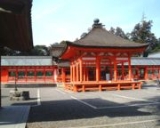
Nangu Taisha
Encyclopedia
.jpg)
Shinto
or Shintoism, also kami-no-michi, is the indigenous spirituality of Japan and the Japanese people. It is a set of practices, to be carried out diligently, to establish a connection between present day Japan and its ancient past. Shinto practices were first recorded and codified in the written...
shrine located in the town of Tarui
Tarui, Gifu
is a town located in Fuwa District, Gifu, Japan.As of July 2011, the town has an estimated population of 28,461. The total area is 57.14 km².- Railroad :*JR Tōkai**Tōkaidō Main Line - Tarui Station-External links:*...
in Fuwa District
Fuwa District, Gifu
is a district located in Gifu, Japan.As of July 2011, the district has an estimated population of 36,426. The total area is 106.43 km²....
, Gifu Prefecture
Gifu Prefecture
is a prefecture located in the Chūbu region of central Japan. Its capital is the city of Gifu.Located in the center of Japan, it has long played an important part as the crossroads of Japan, connecting the east to the west through such routes as the Nakasendō...
, Japan
Japan
Japan is an island nation in East Asia. Located in the Pacific Ocean, it lies to the east of the Sea of Japan, China, North Korea, South Korea and Russia, stretching from the Sea of Okhotsk in the north to the East China Sea and Taiwan in the south...
.
History
The shrine was first built during Emperor JimmuEmperor Jimmu
was the first Emperor of Japan, according to the traditional order of succession. He is also known as Kamuyamato Iwarebiko and personally as Wakamikenu no Mikoto or Sano no Mikoto....
's reign, who lived from 711 BCE to 585 BCE.
During the nearby Battle of Sekigahara
Battle of Sekigahara
The , popularly known as the , was a decisive battle on October 21, 1600 which cleared the path to the Shogunate for Tokugawa Ieyasu...
in 1600, the shrine was completely burnt to the ground and was not rebuilt until 1642, when Tokugawa Iemitsu
Tokugawa Iemitsu
Tokugawa Iemitsu was the third shogun of the Tokugawa dynasty. He was the eldest son of Tokugawa Hidetada, and the grandson of Tokugawa Ieyasu. Iemitsu ruled from 1623 to 1651.-Early life :...
led the construction efforts.
In 1867, as a result of shinbutsu bunri
Shinbutsu Bunri
The term in Japanese indicates the forbidding by law of the amalgamation of kami and buddhas made during the Meiji Restoration. It also indicates the effort made by the Japanese government to create a clear division between native kami beliefs and Buddhism on one side, and Buddhist temples and...
, the Buddhist
Buddhism
Buddhism is a religion and philosophy encompassing a variety of traditions, beliefs and practices, largely based on teachings attributed to Siddhartha Gautama, commonly known as the Buddha . The Buddha lived and taught in the northeastern Indian subcontinent some time between the 6th and 4th...
temple located on the shrine grounds was moved to a different location. That temple is now named Shinzen-in (真禅院) and is still located in Tarui.
This shrine was recorded in the Engishiki Jinmyōchō (延喜式神名帳), a book from the mid-10th century; at that time, the shrine was Mino Province
Mino Province
, one of the old provinces of Japan, encompassed part of modern-day Gifu Prefecture. It was sometimes called . Mino Province bordered Echizen, Hida, Ise, Mikawa, Ōmi, Owari, and Shinano Provinces....
's ichinomiya
Ichinomiya (disambiguation)
Ichinomiya is historically the supreme shrine in each of the old provinces of Japan, and currently the name of several places in Japan:*a city:**Ichinomiya, Aichi containing the shrine of the old province Owari...
. In 1871, it was called Nangū Shrine (南宮神社 Nangū Jinja), but was promoted to a taisha (大社 grand shrine) in 1925. Its name was changed to Nangū Taisha after World War II
World War II
World War II, or the Second World War , was a global conflict lasting from 1939 to 1945, involving most of the world's nations—including all of the great powers—eventually forming two opposing military alliances: the Allies and the Axis...
to reflect its promotion.
See also
- List of Shinto shrines
- Twenty-Two Shrines
- Modern system of ranked Shinto ShrinesModern system of ranked Shinto ShrinesThe The The (sometimes called simply , was an organizational aspect of the establishment of Japanese State Shinto. This system classified Shinto shrines as either official government shrines or "other" shrines...

